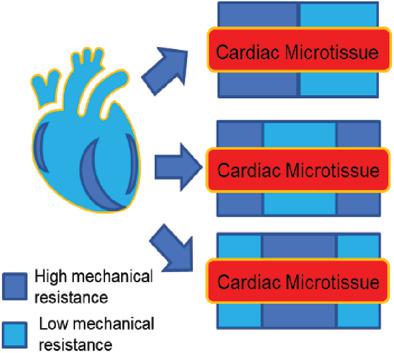当前位置:
X-MOL 学术
›
Adv. Healthcare Mater.
›
论文详情
Our official English website, www.x-mol.net, welcomes your feedback! (Note: you will need to create a separate account there.)
Maladaptive Contractility of 3D Human Cardiac Microtissues to Mechanical Nonuniformity.
Advanced Healthcare Materials ( IF 10.0 ) Pub Date : 2020-02-23 , DOI: 10.1002/adhm.201901373 Chenyan Wang 1 , Sangmo Koo 2 , Minok Park 2 , Zacharias Vangelatos 2 , Plansky Hoang 1 , Bruce R Conklin 3 , Costas P Grigoropoulos 2 , Kevin E Healy 4, 5 , Zhen Ma 1
Advanced Healthcare Materials ( IF 10.0 ) Pub Date : 2020-02-23 , DOI: 10.1002/adhm.201901373 Chenyan Wang 1 , Sangmo Koo 2 , Minok Park 2 , Zacharias Vangelatos 2 , Plansky Hoang 1 , Bruce R Conklin 3 , Costas P Grigoropoulos 2 , Kevin E Healy 4, 5 , Zhen Ma 1
Affiliation

|
Cardiac tissues are able to adjust their contractile behavior to adapt to the local mechanical environment. Nonuniformity of the native tissue mechanical properties contributes to the development of heart dysfunctions, yet the current in vitro cardiac tissue models often fail to recapitulate the mechanical nonuniformity. To address this issue, a 3D cardiac microtissue model is developed with engineered mechanical nonuniformity, enabled by 3D-printed hybrid matrices composed of fibers with different diameters. When escalating the complexity of tissue mechanical environments, cardiac microtissues start to develop maladaptive hypercontractile phenotypes, demonstrated in both contractile motion analysis and force-power analysis. This novel hybrid system could potentially facilitate the establishment of "pathologically-inspired" cardiac microtissue models for deeper understanding of heart pathology due to nonuniformity of the tissue mechanical environment.
中文翻译:

3D 人体心脏微组织对机械不均匀性的适应不良收缩性。
心脏组织能够调整其收缩行为以适应局部机械环境。天然组织机械性能的不均匀性会导致心脏功能障碍的发展,但目前的体外心脏组织模型往往无法重现机械的不均匀性。为了解决这个问题,开发了一种具有工程机械不均匀性的 3D 心脏微组织模型,通过由不同直径的纤维组成的 3D 打印混合矩阵来实现。当组织机械环境的复杂性不断增加时,心脏微组织开始出现适应不良的过度收缩表型,这在收缩运动分析和力功率分析中都得到了证明。这种新颖的混合系统可能有助于建立“受病理启发”的心脏微组织模型,以更深入地了解由于组织机械环境的不均匀性而导致的心脏病理学。
更新日期:2020-04-21
中文翻译:

3D 人体心脏微组织对机械不均匀性的适应不良收缩性。
心脏组织能够调整其收缩行为以适应局部机械环境。天然组织机械性能的不均匀性会导致心脏功能障碍的发展,但目前的体外心脏组织模型往往无法重现机械的不均匀性。为了解决这个问题,开发了一种具有工程机械不均匀性的 3D 心脏微组织模型,通过由不同直径的纤维组成的 3D 打印混合矩阵来实现。当组织机械环境的复杂性不断增加时,心脏微组织开始出现适应不良的过度收缩表型,这在收缩运动分析和力功率分析中都得到了证明。这种新颖的混合系统可能有助于建立“受病理启发”的心脏微组织模型,以更深入地了解由于组织机械环境的不均匀性而导致的心脏病理学。



























 京公网安备 11010802027423号
京公网安备 11010802027423号